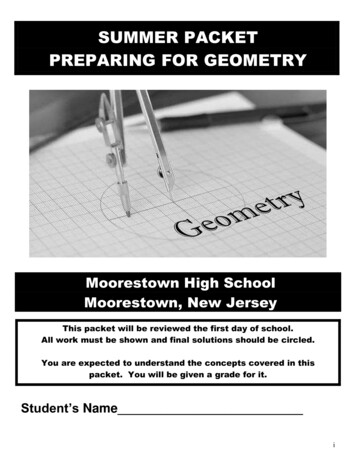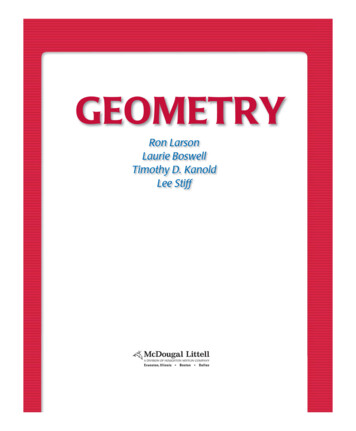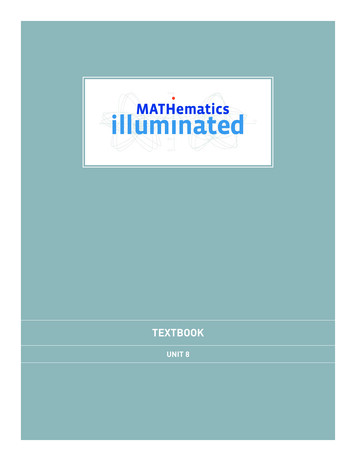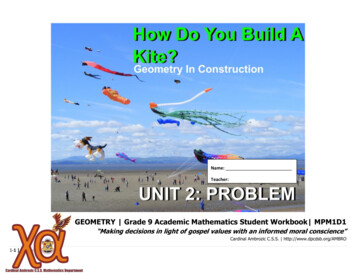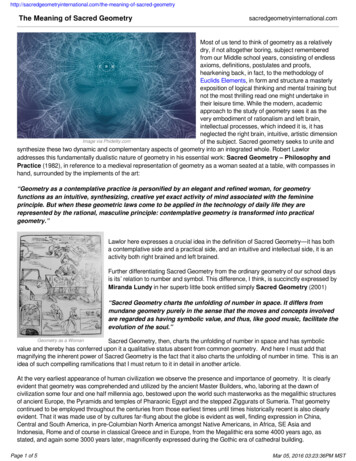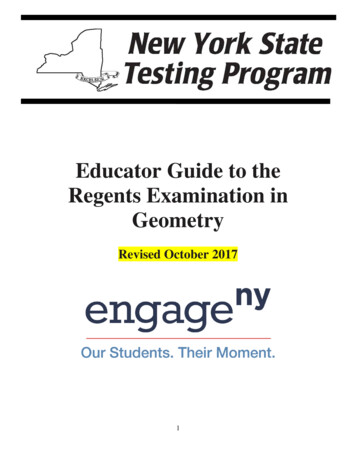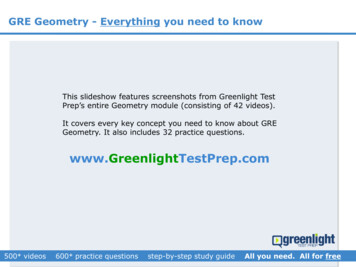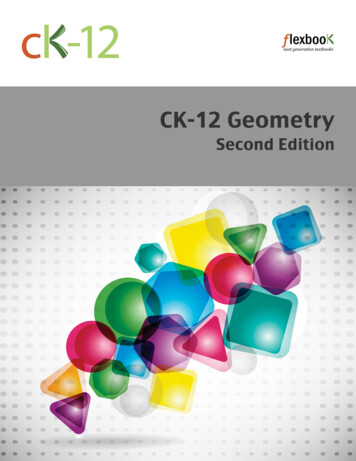
Transcription
CK-12 Geometry - SecondEdition, Answer KeyCK-12 FoundationSay Thanks to the AuthorsClick http://www.ck12.org/saythanks(No sign in required)
www.ck12.orgTo access a customizable version of this book, as well as otherinteractive content, visit www.ck12.orgAUTHORCK-12 FoundationCK-12 Foundation is a non-profit organization with a missionto reduce the cost of textbook materials for the K-12 marketboth in the U.S. and worldwide. Using an open-content, webbased collaborative model termed the FlexBook textbook, CK-12intends to pioneer the generation and distribution of high-qualityeducational content that will serve both as core text as well asprovide an adaptive environment for learning, powered throughthe FlexBook Platform .Copyright 2015 CK-12 Foundation, www.ck12.orgThe names “CK-12” and “CK12” and associated logos and theterms “FlexBook ” and “FlexBook Platform ” (collectively“CK-12 Marks”) are trademarks and service marks of CK-12Foundation and are protected by federal, state, and internationallaws.Any form of reproduction of this book in any format or medium,in whole or in sections must include the referral attribution linkhttp://www.ck12.org/saythanks (placed in a visible location) inaddition to the following terms.Except as otherwise noted, all CK-12 Content (including CK-12Curriculum Material) is made available to Users in accordancewith the Creative Commons Attribution-Non-Commercial 3.0Unported (CC BY-NC 3.0) License (http://creativecommons.org/licenses/by-nc/3.0/), as amended and updated by Creative Commons from time to time (the “CC License”), which is incorporatedherein by this reference.Complete terms can be found at http://www.ck12.org/about/terms-of-use.Printed: February 25, 2015iii
Contentswww.ck12.orgContents12345ivBasics of Geometry, Answer Key1.1Geometry - Second Edition, Points, Lines, and Planes, Review Answers1.2Geometry - Second Edition, Segments and Distance, Review Answers .1.3Geometry - Second Edition, Angles and Measurement, Review Answers1.4Geometry - Second Edition, Midpoints and Bisectors, Review Answers .1.5Geometry - Second Edition, Angle Pairs, Review Answers . . . . . . .1.6Geometry - Second Edition, Classifying Polygons, Review Answers . .1.7Geometry - Second Edition, Chapter Review Answers . . . . . . . . . .125710131417Reasoning and Proof, Answer Key2.1Geometry - Second Edition, Inductive Reasoning, Review Answers . . . . . . . . . . .2.2Geometry - Second Edition, Conditional Statements, Review Answers . . . . . . . . .2.3Geometry - Second Edition, Deductive Reasoning, Review Answers . . . . . . . . . .2.4Geometry - Second Edition, Algebraic and Congruence Properties, Review Answers . .2.5Geometry - Second Edition, Proofs about Angle Pairs and Segments, Review Answers .2.6Chapter Review Answers . . . . . . . . . . . . . . . . . . . . . . . . . . . . . . . . .18192123262933.Parallel and Perpendicular Lines, Answer Key3.1Geometry - Second Edition, Lines and Angles, Review Answers . . . . . . . . . . . .3.2Geometry - Second Edition, Properties of Parallel Lines, Review Answers . . . . . . .3.3Geometry - Second Edition, Proving Lines Parallel, Review Answers . . . . . . . . . .3.4Geometry - Second Edition, Properties of Perpendicular Lines, Review Answers . . . .3.5Geometry - Second Edition, Parallel and Perpendicular Lines in the Coordinate Plane,Answers . . . . . . . . . . . . . . . . . . . . . . . . . . . . . . . . . . . . . . . . . .3.6Geometry - Second Edition, The Distance Formula, Review Answers . . . . . . . . . .3.7Chapter Review Answers . . . . . . . . . . . . . . . . . . . . . . . . . . . . . . . . . . . . . . . . . . . . . . . . .Review. . . . . . . . . . . . .3435374042434749Triangles and Congruence, Answer key4.1Geometry - Second Edition, Triangle Sums, Review Answers . . . . . . . . . . . . . . . . . .4.2Geometry - Second Edition, Congruent Figures, Review Answers . . . . . . . . . . . . . . . .4.3Geometry - Second Edition, Triangle Congruence using SSS and SAS, Review Answers . . . .4.4Geometry - Second Edition, Triangle Congruence using ASA, AAS, and HL, Review Answers4.5Geometry - Second Edition, Isosceles and Equilateral Triangles, Review Answers . . . . . . .4.6Chapter 4 Review Answers . . . . . . . . . . . . . . . . . . . . . . . . . . . . . . . . . . . .50515355586063Relationships with Triangles, Answer Key5.1Geometry - Second Edition, Midsegments of a Triangle, Review Answers . . . . .5.2Geometry - Second Edition, Perpendicular Bisectors in Triangles, Review Answers5.3Geometry - Second Edition, Angle Bisectors in Triangles, Review Answers . . . .5.4Geometry - Second Edition, Medians and Altitudes in Triangles, Review Answers .5.5Geometry - Second Edition, Inequalities in Triangles, Review Answers . . . . . . .5.6Geometry - Second Edition, Extension: Indirect Proof, Review Answers . . . . . .64656771737576.
www.ck12.org5.76789ContentsChapter Review Answers . . . . . . . . . . . . . . . . . . . . . . . . . . . . . . . . . . . . . .Polygons and Quadrilaterals, Answer Key6.1Geometry - Second Edition, Angles in Polygons, Review Answers . . . . . . . . . . . .6.2Geometry - Second Edition, Properties of Parallelograms, Review Answers . . . . . . .6.3Geometry - Second Edition, Proving Quadrilaterals are Parallelograms, Review Answers6.4Geometry - Second Edition, Rectangles, Rhombuses and Squares, Review Answers . . .6.5Geometry - Second Edition, Trapezoids and Kites, Review Answers . . . . . . . . . . .6.6Chapter Review Answers . . . . . . . . . . . . . . . . . . . . . . . . . . . . . . . . . .Similarity, Answer Key7.1Geometry - Second Edition, Ratios and Proportions, Review Answers . . .7.2Geometry - Second Edition, Similar Polygons, Review Answers . . . . . .7.3Geometry - Second Edition, Similarity by AA, Review Answers . . . . . .7.4Geometry - Second Edition, Similarity by SSS and SAS, Review Answers .7.5Geometry - Second Edition, Proportionality Relationships, Review Answers7.6Geometry - Second Edition, Similarity Transformations, Review Answers .7.7Geometry - Second Edition, Extension: Self-Similarity, Review Answers . .7.8Chapter Review Answers . . . . . . . . . . . . . . . . . . . . . . . . . . .77.78798183868991.92939495969799101103Right Triangle Trigonometry, Answer Key8.1Geometry - Second Edition, The Pythagorean Theorem, Review Answers . . . . . .8.2Geometry - Second Edition, Converse of the Pythagorean Theorem, Review Answers8.3Geometry - Second Edition, Using Similar Right Triangles, Review Answers . . . . .8.4Geometry - Second Edition, Special Right Triangles, Review Answers . . . . . . . .8.5Geometry - Second Edition, Tangent, Sine and Cosine, Review Answers . . . . . . .8.6Geometry - Second Edition, Inverse Trigonometric Ratios, Review Answers . . . . .8.7Geometry - Second Edition, Extension: Laws of Sines and Cosines, Review Answers8.8Chapter Review Answers . . . . . . . . . . . . . . . . . . . . . . . . . . . . . . . .104105106109111112113114115.Circles, Answer Key9.1Geometry - Second Edition, Parts of Circles and Tangent Lines, Review Answers . . . . . . . .9.2Geometry - Second Edition, Properties of Arcs, Review Answers . . . . . . . . . . . . . . . . .9.3Geometry - Second Edition, Properties of Chords, Review Answers . . . . . . . . . . . . . . . .9.4Geometry - Second Edition, Inscribed Angles, Review Answers . . . . . . . . . . . . . . . . . .9.5Geometry - Second Edition, Angles of Chords, Secants, and Tangents, Review Answers . . . . .9.6Geometry - Second Edition, Segments of Chords, Secants, and Tangents, Review Answers . . .9.7Geometry - Second Edition, Extension: Writing and Graphing the Equations of Circles, ReviewAnswers . . . . . . . . . . . . . . . . . . . . . . . . . . . . . . . . . . . . . . . . . . . . . . .9.8Chapter Review Answers . . . . . . . . . . . . . . . . . . . . . . . . . . . . . . . . . . . . . .10 Perimeter and Area, Answer Key10.1Geometry - Second Edition, Triangles and Parallelograms, Review Answers . . . . . .10.2Geometry - Second Edition, Trapezoids, Rhombi, and Kites, Review Answers . . . . .10.3Geometry - Second Edition, Areas of Similar Polygons, Review Answers . . . . . . . .10.4Geometry - Second Edition, Circumference and Arc Length, Review Answers . . . . .10.5Geometry - Second Edition, Areas of Circles and Sectors, Review Answers . . . . . .10.6Geometry - Second Edition, Area and Perimeter of Regular Polygons, Review Answers10.7Chapter Review Answers . . . . . . . . . . . . . . . . . . . . . . . . . . . . . . . . 3911 Surface Area and Volume, Answer Key14011.1Geometry - Second Edition, Exploring Solids, Review Answers . . . . . . . . . . . . . . . . . . 141v
ometry - Second Edition, Surface Area of Prisms and Cylinders, Review AnswersGeometry - Second Edition, Surface Area of Pyramids and Cones, Review Answers .Geometry - Second Edition, Volume of Prisms and Cylinders, Review Answers . . .Geometry - Second Edition, Volume of Pyramids and Cones, Review Answers . . . .Geometry - Second Edition, Surface Area and Volume of Spheres, Review Answers .Geometry - Second Edition, Exploring Similar Solids, Review Answers . . . . . . .Chapter Review Answers . . . . . . . . . . . . . . . . . . . . . . . . . . . . . . . .12 Rigid Transformations, Answer Key12.1Geometry - Second Edition, Exploring Symmetry, Review Answers . . . . . . .12.2Geometry - Second Edition, Translations and Vectors , Review Answers . . . .12.3Geometry - Second Edition, Reflections, Review Answers . . . . . . . . . . . .12.4Geometry - Second Edition, Rotations, Review Answers . . . . . . . . . . . . .12.5Geometry - Second Edition, Composition of Transformations, Review Answers12.6Geometry - Second Edition, Extension: Tessellations, Review Answers . . . . .12.7Chapter Review Answers . . . . . . . . . . . . . . . . . . . . . . . . . . . . .vi.143144146147148150151.152153155156158162163164
www.ck12.orgChapter 1. Basics of Geometry, Answer KeyC HAPTER1Basics of Geometry,Answer KeyChapter Outline1.1G EOMETRY - S ECOND E DITION , P OINTS , L INES , AND P LANES , R EVIEW A N SWERS1.2G EOMETRY - S ECOND E DITION , S EGMENTS AND D ISTANCE , R EVIEW A NSWERS1.3G EOMETRY - S ECOND E DITION , A NGLES AND M EASUREMENT, R EVIEW A N SWERS1.4G EOMETRY - S ECOND E DITION , M IDPOINTS AND B ISECTORS , R EVIEW A N SWERS1.5G EOMETRY - S ECOND E DITION , A NGLE PAIRS , R EVIEW A NSWERS1.6G EOMETRY - S ECOND E DITION , C LASSIFYING P OLYGONS , R EVIEW A NSWERS1.7G EOMETRY - S ECOND E DITION , C HAPTER R EVIEW A NSWERS1
1.1. Geometry - Second Edition, Points, Lines, and Planes, Review Answerswww.ck12.org1.1 Geometry - Second Edition, Points, Lines,and Planes, Review AnswersFor 1-5, answers will vary. One possible answer for each is included.1.2.3.4. 6. W X, YW , line m, XY and WY .25.
www.ck12.orgChapter 1. Basics of Geometry, Answer Key7. Plane V or plane RST .8. In addition to the pictures to the right, three planes may not intersect at all and can be parallel.9. A 4.25.26.27.28. PQ intersects RS at point Q. AC and AB are coplanar and point D is not. Points E and H are coplanar, but their rays, EF and GH are non-coplanar. IJ , IK, IL, and IM with common endpoint I and J, K, L and M are erAlwaysSometimesNeverAlwaysSometimes#18: By definition, a point does not take up any space, it is only a location. #21: The ray is never read “BA,”the endpoint is always stated first.To make #15 true, they must be three non-collinear points. For #16, the two rays must lie on the same line,which it does not state. For #20, four points could be coplanar, but you only need three points to make a plane,so the fourth point could be in another plane. For #23, theorems can also be proven true by definitions andpreviously proven theorems.The walls, ceiling and floor are all planes. When two of them intersect the intersection is a line (i.e. the ceilingand a wall). When two walls and either the ceiling or the floor intersect the intersection is a point.The spokes on a wheel are segments. They intersect at a point.Cities on a map are points and the distance between them can be found by measuring the segment connectingthe points.29-33.3
1.1. Geometry - Second Edition, Points, Lines, and Planes, Review Answers4www.ck12.org
www.ck12.orgChapter 1. Basics of Geometry, Answer Key1.2 Geometry - Second Edition, Segments andDistance, Review Answers1.2.3.4.5.6.7.8.1.625 in2.875 in3.7 cm8.2 cm2.75 in4.9 cm4.625 in8.7 cm9.10. O would be halfway between L and T , so that LO OT 8 cm11.a.b. TA AQ T Qc. T Q 15 in12.a.b. HM MA HAc. AM 11 cm13. BC 8 cm, BD 25 cm, and CD 17 cm14. FE 8 in, HG 13 in, and FG 17 in15.a.b.c.d.16.17.18.19.20.21.RS 4QS 14TS 8TV 12x 3, HJ 21, JK 12, HK 33x 11, HJ 52, JK 79, HK 131x 1, HJ 2 31 , JK 5 32 , HK 8x 17, HJ 27, JK 153, KH 180x 16, HJ 7, JK 15, KH 22One possible answer.5
1.2. Geometry - Second Edition, Segments and Distance, Review Answerswww.ck12.org 7 ( 6) 13 3 2 5 0 ( 9) 9 4 1 5Answers vary, but hopefully most students found their heights to be between 7 and 8 heads.Answers should include some reference to the idea that multiplying and dividing by ten (according to theprefixes) is much easier than keeping track of 12 inches in a ft, 3 ft in a yard, 5280 ft in a mile, etc.28. Answers vary, but students should recognize that the pedometer is more likely to yield a false reading becausea person’s stride length varies. One possible way to minimize this error would be to average a person’s stridelength over a relatively long distance-i.e. count the number of steps taken in 100 m.29. Answers vary. The cubit was the first recorded unit of measure and it was integral to the building of theEgyptian pyramids.30. Students should comment on the “ideal” proportions found in the human face and how these correspond toour perception of beauty.22.23.24.25.26.27.6
www.ck12.orgChapter 1. Basics of Geometry, Answer Key1.3 Geometry - Second Edition, Angles andMeasurement, Review Answers1.2.3.4.5.6.7.8.9.10.11.False, two angles could be 5 and 30 .False, it is a straight angle.TrueTrueFalse, you use a compass.False, B is the vertex.TrueTrueTrueFalse, it is equal to the sum of the smaller angles within it.Acute12. Obtuse13. Obtuse14. Acute15. Obtuse7
1.3. Geometry - Second Edition, Angles and Measurement, Review Answers16. Acute17 & 18: Drawings should look exactly like 12 and 16, but with the appropriate arc marks.19.20.21.22.23.40 122 18 87 AE CD, ED CB, m6 EDC 90 , m6 EAC m6 ABC24.25. An interior point would be (2, 0).26. An interior point would be (2, 0).8www.ck12.org
www.ck12.org28.29.30.31.32.33.34.35.36.Chapter 1. Basics of Geometry, Answer Key27.m6 QOP 100 m6 QOT 130 m6 ROQ 30 m6 SOP 70 (x 7) (2x 19) 56 (3x 26) 56 3x 30 x 10 (4x 23) (4x 23) 130 (8x 46) 130 8x 176 x 22 (5x 13) 90 (16x 55) (5x 77) (16x 55) 22 11x x 2 (x 9) (5x 1) (9x 80) (6x 8) (9x 80) 72 3x x 24 Students should comment about the necessity to have a number of degrees in a line that is divisible by 30, 45,60 and 90 degrees because these degree measures are prevalent in the study of geometrical figures. Basically,setting the measure of a straight line equal to 180 degrees allows us to have more whole number degreemeasures in common geometrical figures.9
1.4. Geometry - Second Edition, Midpoints and Bisectors, Review Answerswww.ck12.org1.4 Geometry - Second Edition, Midpoints andBisectors, Review 8.19.20.21.22.23.24.25.12 in5 in5 in13 in90 10 in24 in90 8 trianglesPSQT ,V S90 45 bisectorbisectorPU is a segment bisector of QT45 x 9, y 14 x 14 x 20 d 13 x 12a 22 , x 12 55 each26. 37.5 each10
www.ck12.orgChapter 1. Basics of Geometry, Answer Key27. 3.5 cm each28. 2 in each29. You created a right, or 90 angle.30.31.32.33.34.(3, -5)(1.5, -6)(5, 5)(-4.5, 2)(7, 10)11
1.4. Geometry - Second Edition, Midpoints and Bisectors, Review Answerswww.ck12.org35. (6, 9)36. This is incorrect. She should have written AB CD or AB CD.37. This formula will give the same answer. x1 x2 y1 y2, (mx , my )22y1 y2x1 x2 mx and my22amp; x1 x2 2mx and y1 y2 2myamp; x1 2mx x2For#34,and y1 2my y2x1 2(3) ( 1) 7y1 2(6) 2 1038.39. A square or a rectangle.40. Midpoint could be used to determine where you might want to make a stop halfway through a trip (if using amap the longitude and latitude could be used in the formula for midpoint). We often want to find the middleof something-the middle of a wall to hang a picture, the middle of a room to divide it in half, etc.12
www.ck12.orgChapter 1. Basics of Geometry, Answer Key1.5 Geometry - Second Edition, Angle Pairs,Review Answers1.a.b.c.d.45 8 71 (90 z) a.b.c.d.135 62 148 (180 x) 2.3.4.5.6.7.6666JNI and 6 MNL (or 6 INM and 6 JNL)INM and 6 MNL (or 6 INK and 6 KNL )INJand 6 JNKINM and 6 MNL (or 6 INK and 6 1.22.23.24.25.26.27.28.29.30.31.117 90 63 117 ysx 7 x 34 y 13 x 17 x 15 y 9 y 8 x 10.5 x 4 y 3 x 67 , y 40 x 38 , y 25 x 15 , x 4 x 11 , x 2 x 1 102, x 1 102x 11 , y 7 13
1.6. Geometry - Second Edition, Classifying Polygons, Review Answerswww.ck12.org1.6 Geometry - Second Edition, ClassifyingPolygons, Review Acute scalene triangleEquilateral and equiangular triangleRight isosceles triangle.Obtuse scalene triangleAcute isosceles triangleObtuse isosceles triangleNo, there would be more than 180 in the triangle, which is impossible.No, same reason as #7.9.All the angles in an equilateral triangle must be equal. So, an equilateral triangle is also an equiangulartriangle.Concave pentagonConvex octagonConvex 17-gonConvex decagonConcave quadrilateralConcave hexagonA is not a polygon because the two sides do not meet at a vertex; B is not a polygon because one side is curved;C is not a polygon because it is not closed.2 diagonals19. 5 diagonals14
www.ck12.orgChapter 1. Basics of Geometry, Answer Key20. A dodecagon has twelve sides, so you can draw nine diagonals from one vertex.21. The pattern is belowTABLE 1.1:Number of sides3456789101112Diagonals from one vertex0123456789This shows us that the number diagonals from one vertex increase by one each time. So, for an n gon, there are(n 3) diagonals from one vertex.22. Octagon has 20 total diagonals Nonagon has 27 total diagonals Decagon has 35 total diagonals Undecagonhas 44 total diagonals Dodecagon has 54 total diagonals The pattern is 0, 2, 5, 9, 14, 20, 27, 35, 44, 54. Tofind the next term you would add one more than was added previously. For example, the next term you wouldadd 11. The equation is n(n 3)2 .23. Sometimes24. Always25. Always26. Never27. Always28. Sometimes, a square is ALWAYS a quadrilateral.29. Sometimes, you can draw AT MOST n 3 diagonals from one vertex.30. Sometimes, a 5-point star is ALWAYS a decagon.For questions 31-34 answers will vary.31.15
1.6. Geometry - Second Edition, Classifying Polygons, Review Answers32.33.34. a rhombus or diamond35. This triangle is to scale.36. Use #9 to help you. It is the same construction, but do not draw the third side.16www.ck12.org
www.ck12.orgChapter 1. Basics of Geometry, Answer Key1.7 Geometry - Second Edition, Chapter Review OJGIKDCN17
www.ck12.orgC HAPTER2Reasoning and Proof,Answer KeyChapter Outline2.1G EOMETRY - S ECOND E DITION , I NDUCTIVE R EASONING , R EVIEW A NSWERS2.2G EOMETRY - S ECOND E DITION , C ONDITIONAL S TATEMENTS , R EVIEW A N SWERS182.3G EOMETRY - S ECOND E DITION , D EDUCTIVE R EASONING , R EVIEW A NSWERS2.4G EOMETRY - S ECOND E DITION , A LGEBRAIC AND C ONGRUENCE P ROPERTIES ,R EVIEW A NSWERS2.5G EOMETRY - S ECOND E DITION , P ROOFS ABOUT A NGLE PAIRS AND S EG MENTS , R EVIEW A NSWERS2.6C HAPTER R EVIEW A NSWERS
www.ck12.orgChapter 2. Reasoning and Proof, Answer Key2.1 Geometry - Second Edition, Inductive Reasoning, Review Answers1. 9, 212. 20, 1103.a.b. there are two more points in each star than its figure number.c. n 24.a. 10;b. 48c. , 23; 107; 3n 2 19, 24; 164; 5n 1164, 128; 34, 359, 738, 368; 2n12, 1; 307; 11n 78 12, 0; 93; odd terms: 3n 12, even terms: 4n6 7 35 n7 , 8 ; 36 ; n 12n12 14 7023 , 27 ; 139 ; 4n 1 13, 15; 71; ( 1)n 1 (2n 1)21, 25; 137; ( 1)n (4n 3)1 1 1 ( 1)n12 , 14 ; 70 ; 2n8, 11; 73; odd terms 2n 3, even terms 2n 1436, 49; 1225; n238, 51; the amount that is added is increasing by two with each term.48, 63; the amount that is added is increasing by two with each term.216, 343; the term number cubed, n3 .8, 13; add the previous two terms together to get the current term.There is a good chance that Tommy will see a deer, but it is not definite. He is reasoning correctly, but thereare other factors that might affect the outcome.19
2.1. Geometry - Second Edition, Inductive Reasoning, Review Answerswww.ck12.org22. Maddie has experimented multiple times and recognized a pattern in her results. This is a good example ofinductive reasoning.23. Juan does not use inductive reasoning correctly. It is important that conclusions are based on multipleobservations which establish a pattern of results. He only has one trial.24. Answers vary-correct answers should include multiple experiments or trials which indicate a clear pattern foroutcomes.25. Answers vary.26. n(n 3)227. (n 1)(n 2)228. n(n 1)(n 2)229. Students should notice that the points are collinear. Thus, they could find the rule by finding the equation ofthe line using any two of the three points. The equation is y 5x 2.30. The sequences in problems 5, 6 and 8 are of the same type. They can be modeled by linear equations becausethey have a constant “slope” or rate of change. In other words, the same value is added or subtracted each timeto get the next term.20
www.ck12.orgChapter 2. Reasoning and Proof, Answer Key2.2 Geometry - Second Edition, ConditionalStatements, Review ypothesis: 5 divides evenly into x. Conclusion: x ends in 0 or 5.Hypothesis: A triangle has three congruent sides. Conclusion: It is an equilateral triangle.Hypothesis: Three points lie in the same plane. Conclusion: The three points are coplanar.Hypothesis: x 3. Conclusion: x2 9.Hypothesis: You take yoga. Conclusion: You are relaxed.Hypothesis: You are a baseball player. Conclusion: You wear a hat.Converse: If x ends in 0 or 5, then 5 divides evenly into x. True. Inverse: If 5 does not divide evenly into x,then x does not end in 0 or 5. True. Contrapositive: If x does not end in 0 or 5, then 5 does not divide evenlyinto it. TrueConverse: If you are relaxed, then you take yoga. False. You could have gone to a spa. Inverse: If you do nottake yoga, then you are not relaxed. False. You can be relaxed without having had taking yoga. You couldhave gone to a spa. Contrapositive: If you are not relaxed, then you did not take yoga. TrueConverse: If you wear a hat, then you are a baseball player. False. You could be a cowboy or anyone else whowears a hat. Inverse: If you are not a baseball player, then you do not wear a hat. False. Again, you could bea cowboy. Contrapositive: If you do not wear a hat, then you are not a baseball player. TrueIf a triangle is equilateral, then it has three congruent sides. True. A triangle has three congruent sides if andonly if it is equilateral.If three points are coplanar, then they lie in the same plane. True. Three points lie in the same plane if andonly if they are coplanar.If x2 9, then x 3. False. x could also be -3.If B is the midpoint of AC, then AB 5 and BC 5. This is a true statement.If AB 6 5 and BC 6 5, then B is not the midpoint of AC. This is true.If B is noncollinear with A and C.If AB 6 5 and BC 6 5, then B is not the midpoint of AC. It is the same as #14.the original statementp q p q p qp q18. the contrapositivep q p q q p19. the contrapositivep qq p q p21
2.2. Geometry - Second Edition, Conditional Statements, Review Answerswww.ck12.org20. the original statementp q q p p qp q21. If a U.S. citizen can vote, then he or she is 18 or more years old. If a U.S. citizen is 18 or more years old, thenhe or she can vote.22. If a whole number is prime, then it has exactly two distinct factors. If a whole number has exactly two distinctfactors, then it is prime.23. If points are collinear, then there is a line that contains the points. If there is a line that contains the points,then the points are collinear.24. If 2x 18, then x 9. If x 9, then 2x 18.25.a.b.c.d.Yes.No, x could equal -4.No, again x could equal .Yes.a.b.c.d.Yes.No, 6 ABC could be any value between 0 and 90 degrees.No, again 6 ABC could be any value between 0 and 90 degrees.Yes.26.27.28.29. Answers vary.30. Answers vary.22
www.ck12.orgChapter 2. Reasoning and Proof, Answer Key2.3 Geometry - Second Edition, DeductiveReasoning, Review 8.19.20.21.I am a smart person. Law of DetachmentNo conclusionIf a shape is a circle, then we don’t need to study it. Law of Syllogism.You don’t text while driving. Law of Contrapositive.It is sunny outside. Law of Detachment.You are not wearing sunglasses. Law of Contrapositive.My mom did not ask me to clean my room. Law of Contrapositive.If I go to the park, I will give my dog a bath. Law of Syllogism.This is a sound argument, but it doesn’t make sense because we know that circles exist. p qq rr ss t p tp qp qp q q pIf I need a new watch battery, then I go to the mall. If I go to the mall, then I will shop. If I shop, then I willbuy shoes. Conclusion: If I need a new watch battery, then I will buy shoes.If Anna’s teacher gives notes, then Anna writes them down. If Anna writes down the notes, then she can dothe homework. If Anna can do the homework, then she will get an A on the test. If Anna gets an A on the test,her parents will take her out for ice cream. Conclusion: If Anna’s teacher gives notes, then Anna’s parentswill buy her ice cream.Inductive; a pattern of weather was observed.Deductive; Beth used a fact to determine what her sister would eat.Deductive; Jeff used a fact about Nolan Ryan.Either reasoning. Inductive; surfers observed patterns of weather and waves to determine when the best timeto surf is. Deductive; surfers could take the given statement as a fact and use that to determine when the besttime to surf is.Inductive; observed a pattern.Both-Inductive: Amani noticed a pattern of behavior. Deductive: Amani ruled out possible explanations untilthere was only one remaining.Deductive: The detectives narrowed their field of suspects by eliminating those who couldn’t have committedthe crime.See the following table:TABLE 2.1:pTF pFTp pFF22. See the following table:23
2.3. Geometry - Second Edition, Deductive Reasoning, Review Answerswww.ck12.orgTABLE 2.2:pTTFF pFFTTqTFTF qFTFT p qFTTTq qTTTTp (p q)TTFF23. See the following table:TABLE 2.3:pTTFF qFTFTqTFTF24. See the following table:TABLE 2.4:pTTTTFFFFqTTFFTTFFrTFTFTFTF rFTFTFTFTp qTTFFFFFF(p q) rTTFTFTFT q rTFTTTFTTp ( q r)TTTTTFTT25. See the following table:TABLE 2.5:pTTTTFFFFqTTFFTTFF26. See the following table:24rTFTFTFTF qFFTTFFTT
www.ck12.orgChapter 2. Reasoning and Proof, Answer KeyTABLE FTFTF rFTFTFTFTq rTTFTTTFTp (q r)TTFTFFFFThere are two more T ’s in #24. We can conclude that parenthesis placement matters.p q r is always true except the one case when p, q, and r are all false.True; Law of SyllogismNot validTrue; Law of ContrapositiveNot validTrue; Law of DetachmentNot valid25
2.4. Geometry - Second Edition, Algebraic and Congruence Properties, Review Answerswww.ck12.org2.4 Geometry - Second Edition, Algebraic andCongruence Properties, Review Answers1. 3x 11 163x 27Subtraction PoEx 9Division PoE2. 7x 3 3x 354x 3 35Subtraction PoE4x 32Addition PoEx 8Division PoE23. 3 g 1 192Subtraction PoE3 g 18g 27Multiplication PoE4. 21 MN 5MN 10Multiplication PoE 65. 5m ABC 540m6 ABC 108 Division PoE6. 10b 2(b 3) 5b10b 2b 6 5bDistributive Property8b 6 5bCombine like terms 6 3bSubtraction PoE2 bDivision PoEb 2Symmetric PoE7. 14 y 56 313y 10 4Multiplication PoE (multiplied everything by 12)3y 6Subtraction PoEy 2Division PoE8. 14 AB 31 AB 12 21 AB3AB 4AB 144 6ABMultiplication PoE (multiplied everything by 12)7AB 144 6ABCombine like termsAB 144Subtraction PoE9. 3 x10. 12x 3211. x 1212. y z x y13. CD 514. z 4 y 715. Yes, they are collinear. 16 7 2316. No, they are not collinear, 9 9 6 16. I cannot be the midpoint.17. 6 NOP must be an obtuse angle because it is supplementary with 56 , meaning that m6 NOP is 180 56 124 . 90 124 180 , so by definition 6 NOP is an obtuse angle.18. 6 ABC 6 DEF6
www.ck12.orgChapter 1. Basics of Geometry, Answer Key CHAPTER 1 Basics of Geometry, Answer Key Chapter Outline 1.1 GEOMETRY - SECOND EDITION, POINTS, LINES, AND PLANES, REVIEW AN- SWERS 1.2 GEOMETRY - SECOND EDITION, SEGMENTS AND DISTANCE, REVIEW ANSWERS 1.3


